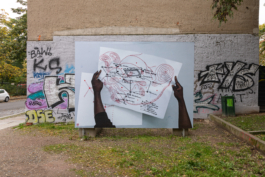
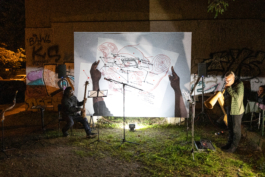
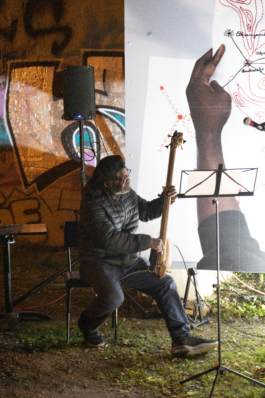
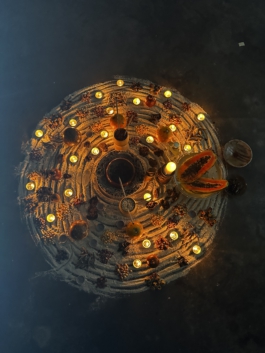
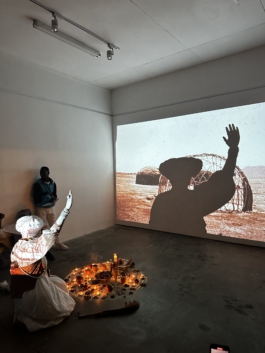
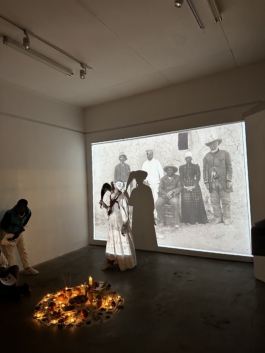

Interpretation of a map // Verklanglichung einer Karte
Frederike Moormann, Nashilongweshipwe Mushaandja, Angelika Waniek
26.10. – 26.11. 2023
Leipzig – Windhoek
Activations:
Leipzig 26.20.2023 // 20:00* musikalische Aktivierung von Gundolf Nandico & Luka Mukavhele
Windhoek 17.11.2023 // 18:00**, Performance by Tuli Mekondjo at Project Space in Windhoek (live via stream at IDEAL)
-see english version below-
* UTC, koordinierte Weltzeit. Namibia und Deutschland liegen in der gleichen Zeitzone
** UTC, koordinierte Weltzeit + 1, da Winterzeit in Deutschland. 18 Uhr in Namibia
Elektrische Telegrafie war eine technische und soziale Vorbedingung des Rundfunks. Der Zeitrahmen der Entwicklung dieser Technologie fällt mit dem Zeitrahmen der deutschen Kolonialzeit zusammen. Von vielen Dokumenten als “entscheidender Durchbruch” oder “Feuertaufe” beschrieben ist der Einsatz mobiler drahtloser Funkstationen im Krieg gegen die Herero und Nama 1904-1908. Codierte Nachrichtenübermittlung über akustische Instrumente (Hörner, Glocken, Trommeln etc.) gibt es jedoch schon seit mehreren tausend Jahren. In unterschiedlichen Regionen der Welt, u.a. in Namibia und Deutschland gab es beispielsweise eine codierte Form, über Hörner akustisch zu telekommunizieren. Unsere transnationale und sowohl wissenschaftliche als auch künstlerische Forschung beschäftigt sich mit der Gewaltgeschichte der Telekommunikationsinfrastruktur und transnationalen Gegenerzählungen in akustischer Telekommunikation durch Hörner.
Electric telegraphy was a technical and social precondition for radio. The timeframe for the development of this technology corresponded with the German colonial period. Many documents describe the use of mobile wireless radio stations in the war against the Herero and Nama in 1904-1908 as a "decisive breakthrough" or "baptism of fire". However, coded message transmission via acoustic instruments (horns, bells, drums, etc.) has existed for several thousand years. In various regions of the world, including Namibia and Germany, for example, there was a coded form of acoustic telecommunication via horns. Our transnational and both scientific and artistic research deals with the history of violence in telecommunications infrastructure and transnational counter-narratives in acoustic telecommunication through horns.
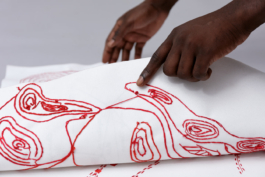
Tuli Mekondjo (Namibia) überträgt das Dokument auf Leinwand und bestickt diese. Es entsteht eine zweiteilige Arbeit. Mapping Memory (2023), Stickerei/Grafik 29,7cmx42cm und 42cmx59,4cm.
“Verbally I am sometimes unable to explain, but I think my body remembers. Everything I am, remembers. It doesn’t matter whether it happened a hundred years ago or whenever. It is there within my system. I can sometimes just sob. Then I go out, and hug myself. And I say to my ancestors: For the first time I start to understand what this pain is about, and why things are as they are today. We haven’t processed these traumas. Until now. We just have been piling them up in our systems. For centuries we haven’t been in dialogue about this. Despite putting a distance, it will always come back. Even if you are trying to avoid it, it will come back to haunt us.
While working on this project, I was confronted with the political power structures that are still at work and lead to our collective "mis-education" as local Namibians. We lack historical education and knowledge about our country, about the colonial infrastructural histories that contain valuable information about how the connections to Namibia's natural resources were made."
-Tuli Mekondjo / Interview with Frederike Moormann & Angelika Waniek, 2023
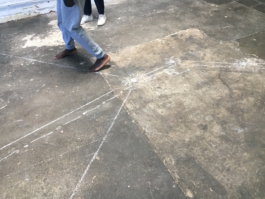
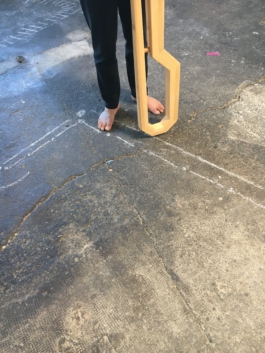
Foto: Frederike Moormann
Eine weitere Gegenerzählung zur militärischen Karte, die zuvor mit Kreide groß auf den Boden gezeichnet wurde, ist die Interpretation von Robert Machiri (Zimbawe) und Gundolf Nandico (Deutschland). Diese nehmen die Zeichnungen der Karte, die immer noch viel kleiner ist als die Landschaft, die sie zu kontrollieren versucht, als Partitur und übersetzen sie in Klang durch Percussion und Vogelhorn.
Another counter-narrative to the military map, which was previously drawn large on the ground with chalk, is the interpretation by Robert Machiri (Zimbawe) and Gundolf Nandico (Germany). They take the drawings of the map – which is still much smaller than the landscape it is trying to control – as a score and translate it into sound through percussion and bird horn.
Die Arbeit Interpretation of a map // Verklanglichung einer Karte // folgt einer kollaborativen künstlerischen Praxis, die die Geschichte an der Seite zu berühren versucht, an der sie Lücken aufweist. Die Arbeit wird zeitgleich im Project Space in Windhoek, Namibia gezeigt. Im Frühjahr 2024 wird sie in einer erweiterten Form als performativer Audiowalk im Theater RAMPE in Stuttgart aufgeführt.
The work Interpretation of a map // Verklanglichung einer Karte follows a collaborative artistic practice that attempts to touch history at the point where it has gaps. The work will be shown simultaneously at IDEAL artspace in Leipzig and Project Space in Windhoek, Namibia. In spring 2024, it will be performed in an expanded form as a performative audio walk at the RAMPE Theater in Stuttgart.
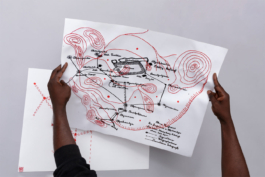
Foto: Gustav Franz
Activations:
Leipzig 26.20.2023 // 20:00* musically by Gundolf Nandico & Luka Mukavhele


Windhoek 17.11.2023 // 18:00**, Performance by Tuli Mekondjo at Project Space in Windhoek (live via stream at IDEAL)

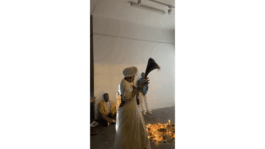
Artistic Team
Frederike Moormann, Nashilongweshipwe Mushaandja, Angelika Waniek sind seit 2022 ein künstlerisch forschendes Team aus Namibia und Deutschland, das sich ortspezifisch recherchierend und performativ mit Themen des transnationalen Musikmachens, der Erinnerungskultur, Gedenk- und Wiedergutmachungsprozessen auseinandersetzt. Frederike Moormann ist Soundkünstlerin, Nashilongweshipwe Mushaandja künstlerischer Forschender und Angelika Waniek Performerin. In ihrem künstlerischen Prozess arbeiten sie mit weiteren künstlerischen Positionen zusammen: Listening at Pungwe (Memory Biwa & Robert Machiri), Friedrich Lober, Gundolf Nandico, Tuli Mekondjo, Luka Mukhavele, West Uarije, Keith Vries.
Frederike Moormann, Nashilongweshipwe Mushaandja, Angelika Waniek have been an artistic research team from Namibia and Germany since 2022, which deals with topics of transnational music making, the culture of remembrance, commemoration and healing processes through site-specific research and performance. Frederike Moormann is a sound artist, Nashilongweshipwe Mushaandja an artistic researcher and Angelika Waniek a performer. In their artistic process they work together with other artistic positions.
Das Projekt wurde gefördert von der Kulturstiftung des Freistaat Sachsens und der Stadt Leipzig sowie vom Fonds Darstellende Künste aus Mitteln der Beauftragten der Bundesregierung für Kultur und Medien im Rahmen von NEUSTART KULTUR. Diese Maßnahme wird mitfinanziert durch Steuermittel auf der Grundlage des vom Sächsischen Landtag beschlossenen Haushaltes.










Interpretation of a map // Verklanglichung einer Karte
Frederike Moormann, Nashilongweshipwe Mushaandja, Angelika Waniek
26.10. – 26.11. 2023
Leipzig – Windhoek
Activations:
Leipzig 26.20.2023 // 20:00* musikalische Aktivierung von Gundolf Nandico & Luka Mukavhele
Windhoek 17.11.2023 // 18:00**, Performance by Tuli Mekondjo at Project Space in Windhoek (live via stream at IDEAL)
-see english version below-
* UTC, koordinierte Weltzeit. Namibia und Deutschland liegen in der gleichen Zeitzone
** UTC, koordinierte Weltzeit + 1, da Winterzeit in Deutschland. 18 Uhr in Namibia
Elektrische Telegrafie war eine technische und soziale Vorbedingung des Rundfunks. Der Zeitrahmen der Entwicklung dieser Technologie fällt mit dem Zeitrahmen der deutschen Kolonialzeit zusammen. Von vielen Dokumenten als “entscheidender Durchbruch” oder “Feuertaufe” beschrieben ist der Einsatz mobiler drahtloser Funkstationen im Krieg gegen die Herero und Nama 1904-1908. Codierte Nachrichtenübermittlung über akustische Instrumente (Hörner, Glocken, Trommeln etc.) gibt es jedoch schon seit mehreren tausend Jahren. In unterschiedlichen Regionen der Welt, u.a. in Namibia und Deutschland gab es beispielsweise eine codierte Form, über Hörner akustisch zu telekommunizieren. Unsere transnationale und sowohl wissenschaftliche als auch künstlerische Forschung beschäftigt sich mit der Gewaltgeschichte der Telekommunikationsinfrastruktur und transnationalen Gegenerzählungen in akustischer Telekommunikation durch Hörner.
Electric telegraphy was a technical and social precondition for radio. The timeframe for the development of this technology corresponded with the German colonial period. Many documents describe the use of mobile wireless radio stations in the war against the Herero and Nama in 1904-1908 as a "decisive breakthrough" or "baptism of fire". However, coded message transmission via acoustic instruments (horns, bells, drums, etc.) has existed for several thousand years. In various regions of the world, including Namibia and Germany, for example, there was a coded form of acoustic telecommunication via horns. Our transnational and both scientific and artistic research deals with the history of violence in telecommunications infrastructure and transnational counter-narratives in acoustic telecommunication through horns.

Interpretation of a map // Verklanglichung einer Karte zeigt Auseinandersetzungen mit einem Dokument aus einem kolonialen Archiv. Eine Karte, die 1904 die telegraphischen Verbindungen der Schutztruppen darstellt während des Krieges gegen und des Völkermordes an den Herero und Nama. Teil der gemeinsamen Arbeit ist die Auseinandersetzung mit diesem kolonialen, gewaltvollen Archivdokument. Performer*innen und Musiker*innen wurden gebeten, auf diese Karte mit ihren jeweiligen künstlerischen Praktiken zu reagieren, um sie zu entwirren, sie freizulegen und sich anzueignen. Was bleibt von einem kolonialen Archiv, wenn ästhetische Praktiken koloniale Machtverhältnisse neu lesen?
Tuli Mekondjo (Namibia) überträgt das Dokument auf Leinwand und bestickt diese. Es entsteht eine zweiteilige Arbeit. Mapping Memory (2023), Stickerei/Grafik 29,7cmx42cm und 42cmx59,4cm.
“Verbally I am sometimes unable to explain, but I think my body remembers. Everything I am, remembers. It doesn’t matter whether it happened a hundred years ago or whenever. It is there within my system. I can sometimes just sob. Then I go out, and hug myself. And I say to my ancestors: For the first time I start to understand what this pain is about, and why things are as they are today. We haven’t processed these traumas. Until now. We just have been piling them up in our systems. For centuries we haven’t been in dialogue about this. Despite putting a distance, it will always come back. Even if you are trying to avoid it, it will come back to haunt us.
While working on this project, I was confronted with the political power structures that are still at work and lead to our collective "mis-education" as local Namibians. We lack historical education and knowledge about our country, about the colonial infrastructural histories that contain valuable information about how the connections to Namibia's natural resources were made."
-Tuli Mekondjo / Interview with Frederike Moormann & Angelika Waniek, 2023


Foto: Frederike Moormann

Foto: Gustav Franz
Activations:
Leipzig 26.20.2023 // 20:00* musically by Gundolf Nandico & Luka Mukavhele
Artistic Team
Frederike Moormann, Nashilongweshipwe Mushaandja, Angelika Waniek sind seit 2022 ein künstlerisch forschendes Team aus Namibia und Deutschland, das sich ortspezifisch recherchierend und performativ mit Themen des transnationalen Musikmachens, der Erinnerungskultur, Gedenk- und Wiedergutmachungsprozessen auseinandersetzt. Frederike Moormann ist Soundkünstlerin, Nashilongweshipwe Mushaandja künstlerischer Forschender und Angelika Waniek Performerin. In ihrem künstlerischen Prozess arbeiten sie mit weiteren künstlerischen Positionen zusammen: Listening at Pungwe (Memory Biwa & Robert Machiri), Friedrich Lober, Gundolf Nandico, Tuli Mekondjo, Luka Mukhavele, West Uarije, Keith Vries.
Frederike Moormann, Nashilongweshipwe Mushaandja, Angelika Waniek have been an artistic research team from Namibia and Germany since 2022, which deals with topics of transnational music making, the culture of remembrance, commemoration and healing processes through site-specific research and performance. Frederike Moormann is a sound artist, Nashilongweshipwe Mushaandja an artistic researcher and Angelika Waniek a performer. In their artistic process they work together with other artistic positions.
Das Projekt wurde gefördert von der Kulturstiftung des Freistaat Sachsens und der Stadt Leipzig sowie vom Fonds Darstellende Künste aus Mitteln der Beauftragten der Bundesregierung für Kultur und Medien im Rahmen von NEUSTART KULTUR. Diese Maßnahme wird mitfinanziert durch Steuermittel auf der Grundlage des vom Sächsischen Landtag beschlossenen Haushaltes.


